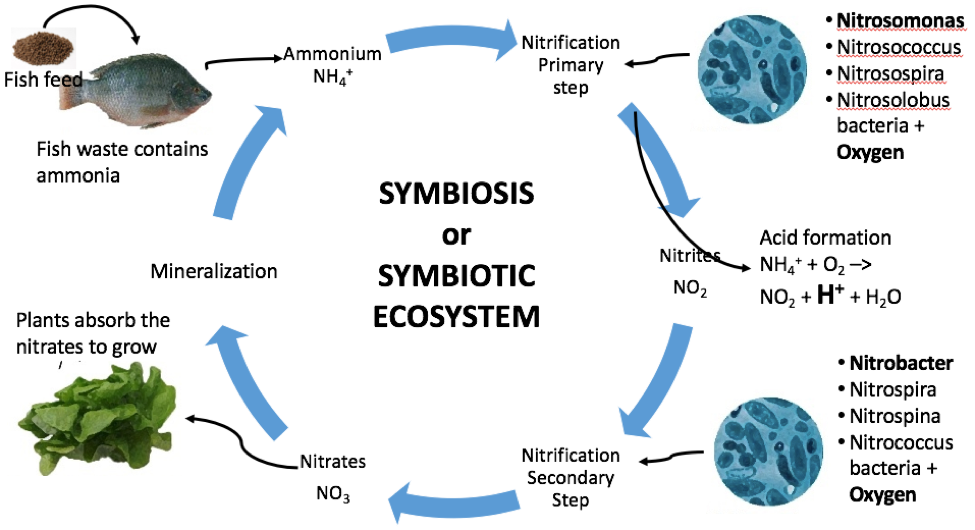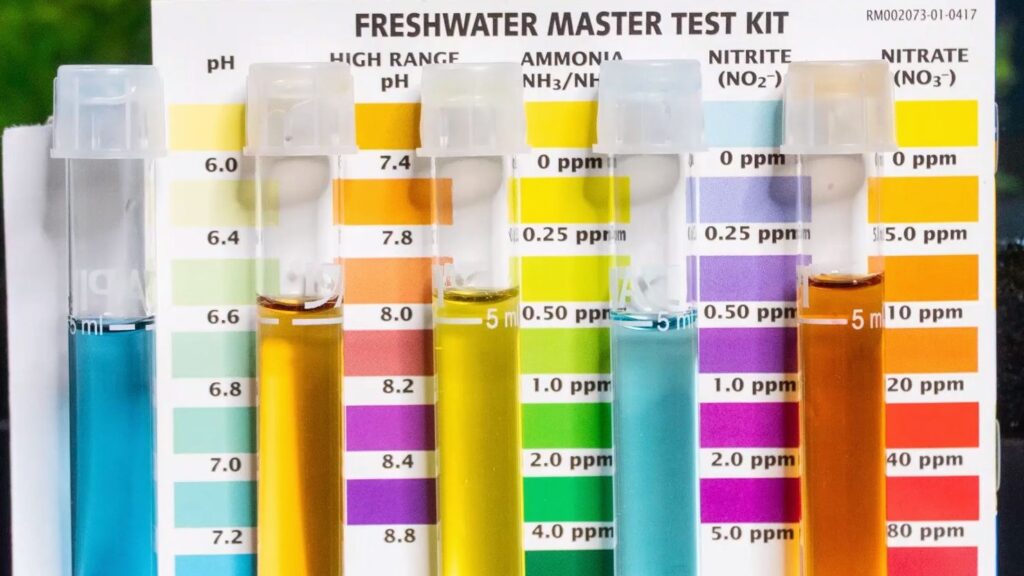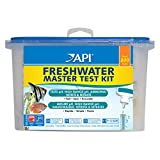In the video I explain which water test kit I use and why pH, ammonia, nitrite and nitrate levels are important to track. They are critical when starting a new aquaponics system.

 This is the test kit we use here…highly recommended.
This is the test kit we use here…highly recommended.
Putting Nitrifiying BACTERIA To Work
Aquaponic systems don’t rely on added chemicals, like hydroponic systems. They essentially hack nature to produce their own necessary chemicals. They do this by utilizing bacteria to convert fish waste into usable nitrate.
The process is displayed in the image below.

Bacteria do all of this work. The 4 water tests described below are paramount to keeping your nitrifying bacteria happy and consequently your plants and fish.
The pH of a solution is a measure of how acidic or basic the solution is on a scale ranging from 1 to 14. A pH of 7 is neutral; anything below 7 is acidic, while anything above 7 is basic. The term pH is defined as the amount of hydrogen ions (H+) in a solution; the more hydrogen ions, the more acidic.
The pH of the water has a major impact on all aspects of aquaponics, especially the plants and bacteria.
For plants, the pH controls the plants’ access to micro- and macronutrients. At a pH of 6.0–6.5, all of the nutrients are readily available, but outside of this range the nutrients become difficult for plants to access. In fact, a pH of 7.5 can lead to nutrient deficiencies of iron, phosphorus and manganese.
Nitrifying bacteria experience difficulty below a pH of 6, and the bacteria’s capacity to convert ammonia into nitrate reduces in acidic, low pH conditions. This can lead to reduced biofiltration, and as a result the bacteria decrease the conversion of ammonia to nitrate, and ammonia levels can begin to increase, leading to an unbalanced system stressful to the other organisms. Fish have specific tolerance ranges for pH as well, but most fish used in aquaponics have a pH tolerance range of 6.0–8.5. However, the pH affects the toxicity of ammonia to fish, with higher pH leading to higher toxicity.
In conclusion, the ideal aquaponic water is slightly acidic, with an optimum pH range of 6–7. This range will keep the bacteria functioning at a high capacity, while allowing the plants full access to all the essential micro- and macronutrients.
Test AMMONIA Levels
Ammonia is toxic to fish. Tilapia and carp can show symptoms of ammonia poisoning at levels as low as 1.0 mg/litre. Prolonged exposure at or above this level will cause damage to the fishes’ central nervous system and gills, resulting in loss of equilibrium, impaired respiration and convulsions. The damage to the gills, often evidenced by red coloration and inflammation on the gills, will restrict the correct functioning of other physiological processes, leading to a suppressed immune system and eventual death. Other symptoms include red streaks on the body, lethargy and gasping at the surface for air. At higher levels of ammonia, effects are immediate and numerous deaths can occur rapidly. However, lower levels over a long period can still result in fish stress, increased incidence of disease and more fish loss.
Test NITRATE Levels
Nitrate is a far less toxic than the other forms of nitrogen. It is the most accessible form of nitrogen for plants, and the production of nitrate is the goal of the biofilter. Fish can tolerate levels of up to 300 mg/liter, with some fish tolerating levels as high as 400 mg/liter. High levels (over 250 mg/liter) will have a negative impact on plants, leading to excessive vegetative growth and hazardous accumulation of nitrates in leaves, which is dangerous for human health. It is recommended to keep the nitrate levels at 5–150 mg/liter and to exchange water when levels become higher.
Test NITRITE Levels
Nitrite is toxic to fish. Similar to ammonia, problems with fish health can arise with concentrations as low as 0.25 mg/liter. High levels of NO2- can immediately lead to rapid fish deaths. Again, even low levels over an extended period can result in increased fish stress, disease and death. Toxic levels of NO2- prevent the transport of oxygen within the bloodstream of fish, which causes the blood to turn a chocolate-brown color and is sometimes known as “brown blood disease”. This effect can be seen in fish gills as well. Affected fish exhibit similar symptoms to ammonia poisoning, particularly where fish appear to be oxygen deprived, seen gasping at the surface even in water.

API FRESHWATER MASTER TEST KIT
CLICK IMAGE TO VIEW ON AMAZON







GIPHY App Key not set. Please check settings
One Comment